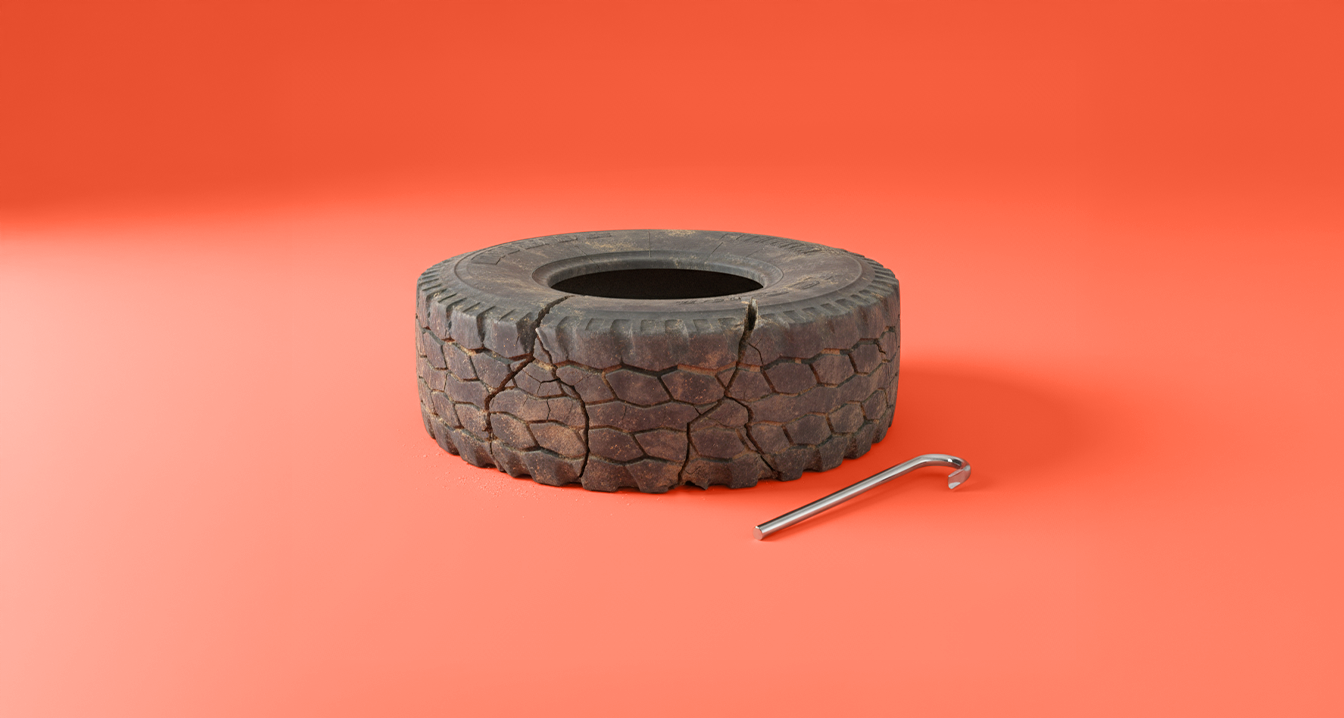Muddy roads are not just an obstacle for the driver... but a direct challenge to the truck's strength, stability and safety. At the heart of this challenge, the tire is the first line of defense. Every muddy pit is only a cunning trap that causes premature wear, unexpected damage, or even an unwelcome accident.
Therefore, whether you are driving in the desert after rain or penetrating dirt roads in rural areas, mud is unforgiving. It may seem just mud, but in fact it is a silent enemy that attacks tires inside and out, weakens their grip and accelerates their damage.
Because trucks and heavy vehicles do not accept complacency, and the tire is the barrier between you and danger, we have collected for you in this article a summary of experience and knowledge. We will reveal to you what mud does to the tire and how to act before the road turns into a trap? Why are your best choice to avoid these challenges, but before that, we must learn about the nature of roads in the Kingdom of Saudi Arabia.
Your driveway tires are the smartest choice in such environments.
The nature of roads in the Kingdom of Saudi Arabia:
The Kingdom of Saudi Arabia is characterized by the diversity of its terrain, from sand dunes in the north and east, to mountainous areas in the south, through agricultural and mud roads in villages and farms. This diversity makes driving outside paved roads common for truck drivers, especially during rainy seasons or when carrying out logistics tasks at construction or energy project sites.
In such circumstances, muddy roads become a real challenge for any tire. There is a need for high-performance tires with specifications that are specifically designed to withstand pressure and avoid slipping.
The impact and damage of muddy areas on trucks and large vehicles:
First of all, we are not talking about large vehicles only, but all vehicles. Muddy areas do not distinguish between large and small ones. Once you enter them, you will get stuck in them even if you are riding a hobby bike, but as usual, we focus on large vehicles for the risks they face permanently.
Some may think that mud is just a minor temporary obstacle, but the reality is that entering it unprepared is like driving your truck amid invisible traps. Mud does not only cover the road, but also penetrates into the heart of the tire and begins to undermine its grip and performance quietly. We will explain to you in detail what actually happens to the tire when it deals with this dangerous environment.

When a truck enters a muddy area, a series of negative effects begin to affect the tire:
- Mud has accumulated inside the grooves of the tire, reducing its effectiveness in holding.
- Increased likelihood of slippage, especially when climbing or cornering.
- Unbalanced friction accelerates tire wear.
- Clogged channels that help cool the tire during long trips.
- Exposure to sudden shocks due to invisible potholes inside the mud.
Imagine all these damages. The first cause is mud. These factors combined not only affect the life of the tire, but also threaten the stability of the load and the safety of the driver. What is the solution then? How can these harmful elements be dealt with? The answer is in the following lines.
How to protect tires when driving in muddy areas:
According to a study published in the Journal of Terra Mechanics in 2020, tires that travel long distances on muddy roads lose their actual grip by up to 35% compared to dry roads, and the rate of tire surface wear increases by 22% to 41%, especially when driving fast or on sticky and unstable soil.
These figures clearly show that the muddy environment does not only consume the road, but also your tires. Therefore, to protect truck tires from the negative effects of muddy areas, a number of procedures are necessary, namely:
- Check air pressure before entering unpaved roads. Improper pressure increases the risk of skidding.
- Do not maintain one speed throughout the road, but switch between speeds depending on the soil condition, and avoid sudden acceleration.
- Do not resist slipping by force, use steering gently, and rationally distribute the weight of the cargo.
- After getting out of the mud, wash the tires immediately to remove the stuck mud that accelerates wear.
- Keep a regular tire maintenance schedule, including visual inspection and balance.
Field trials show that tires that are not designed for mud roads wear up to 40% faster than tires designed for rough conditions.
Signs warning you to stop on muddy roads:
Driving on muddy roads may hide escalating tire problems. The problem is that signs of damage are not always clearly visible, but there are early signs that the tire is beginning to lose its balance or response. Ignoring these signs may put the truck, driver and cargo at risk. These signs and signs include:
- Abnormal vibration in the steering wheel.
- A clicking or whistling sound when walking.
- Unbalanced appearance in the surface of the tire (swelling, cracking, dent).
- Warning light from the tire pressure monitoring system.
Therefore, if you notice any of these signs, do not continue on the muddy road, but stop in a safe area and check the tire immediately.
According to a report issued by the Global Tire Safety Forum in 2021, 43% of heavy tire damage on mud roads were due to ignoring early signs of damage, such as cracks, sound changes, or increased vehicle vibration. The report also showed that 1 in 5 cases of complete loss of control of the vehicle started with a simple indicator in the tire that was ignored.
Why are your driveway tires the best fit for these environments?
Darbek tires have been developed to suit driving challenges in the Gulf, including mud or unpaved areas, as follows:
- The design of deep grooves allows the mud to be expelled quickly.
- A thoughtful surface pattern to reduce slip and enhance grip.
- Rubber materials are resistant to abrasion and cracking in wet environments.
- Field tests in mud environments inside the Kingdom.
- Derbek tires also have stable performance even with a heavy load.
In conclusion...
In Saudi Arabia, muddy roads cannot be avoided, whether in summer or winter. The rainy season turns sandy tracks into slippery areas. Construction works and construction projects force truck drivers to travel in unpaved areas where mud, water and mixed sand create a stressful environment for tires.
In fact, going through mud is not an option... Rather, it is a necessity imposed by the nature of the work, especially in construction projects, or the delivery of equipment to remote locations. Therefore, these roads are muddy due to accumulated water or heavy clay soil. In both cases, they directly affect the ability of the tire to hold together, cool and stabilize.
Therefore, all this confirms that equipping a truck with tires that are not prepared for this environment means exposing the driver, the cargo and the mission to danger.
It is well known in the transport sector that muddy roads are classified as hostile environments for tires due to irregular friction and sudden changes in the level of stability.
Based on all of the above, we recommend you very briefly:
Do not test the patience of your tires in the mud, but rather test the intelligence of your decisions. The harder the road, the more you need a smarter tire. Your path is not just a name, but the best guarantee that you are ready for every turn, every hole and every storm.
So... Keep your tires... Protect your truck... And choose your path.







